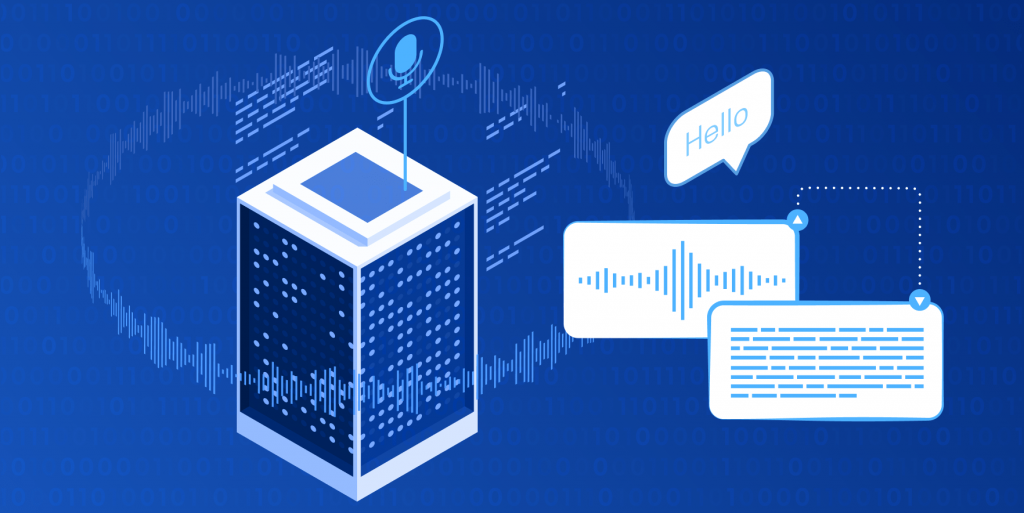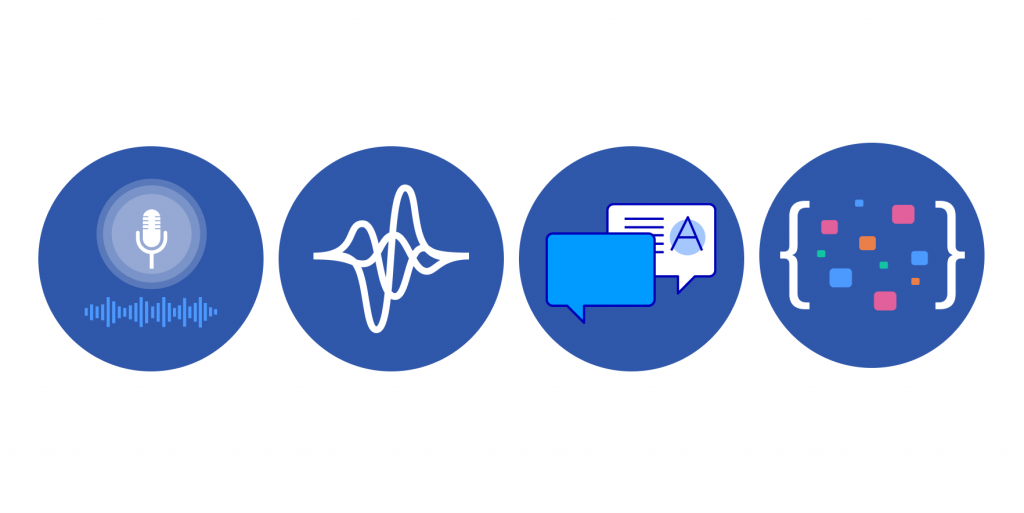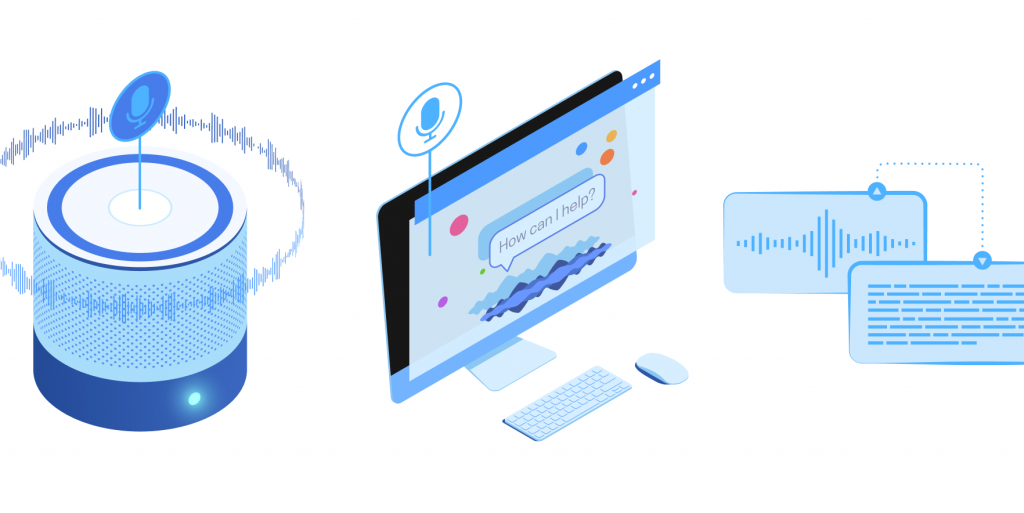Table of Contents
The ASR technology is significantly transforming our daily lives and the way we engage with devices. The increasing demand for speech recognition technology across diverse industries, including healthcare, banking, and retail, serves as a significant driver for the expansion of the market, which is projected to reach US$8.53 billion in 2024, according to Statista.
But what is ASR, exactly? In this article, we will consider the key components of the technology and the diverse applications that leverage its capabilities.

What is ASR?
Automatic speech recognition (ASR) is a technology that converts spoken language into written text. It uses complex algorithms and machine learning techniques to analyze audio signals and transcribe them into text. ASR systems are designed to recognize and interpret human speech, making it possible to convert spoken words into a format that computers can process and understand.
The development of ASR can be traced back to the mid-20th century, when researchers began exploring methods to automate speech recognition. Early systems relied on pattern matching and acoustic modeling techniques, exhibiting limited accuracy and vocabulary coverage. However, with the advent of machine learning and computational advancements, the automatic speech recognition model underwent a significant evolution. The introduction of Hidden Markov Models (HMMs) in the 1970s marked an important moment for ASR, enabling more robust speech recognition capabilities.
Recently, speech recognition has changed a lot with the use of deep learning and neural network-based models. Not too long ago, the prevailing model for speech recognition was wave2text. This technology allowed for the conversion of spoken words into text, enabling a range of applications from virtual assistants to transcribing voice recordings. However, as technology continues to advance at a rapid pace, new models and approaches have emerged.
How does ASR work?
ASR operates through a multi-step process that involves capturing, processing, and interpreting spoken language. The following steps outline the fundamentals of the ASR process:
- Audio input. The process begins with the capture of human speech through a microphone or any audio recording device. The audio input is then digitized to create a digital representation of the spoken words.
- Preprocessing. The digitized audio undergoes preprocessing, which involves filtering out background noise, normalizing the audio levels, and segmenting the speech into smaller units for analysis.
- Feature extraction. During this phase, the system extracts acoustic features from the preprocessed audio, such as mel-frequency cepstral coefficients (MFCCs) or spectrograms. These features serve as the input for the subsequent recognition stage.
- Speech recognition. The extracted features are fed into a speech recognition model that employs machine learning algorithms, such as deep neural networks and Hidden Markov Models (HMMs), to match the acoustic features with linguistic units and generate the corresponding textual output.
- Language modeling. In this step, language models are utilized to enhance the accuracy of recognizing spoken words by considering the context and grammar of the language being spoken.
- Output generation. Finally, the recognized speech is transcribed into written text, which can be further processed for various applications, such as generating subtitles, transcribing meetings, or enabling voice commands for devices.
Speech recognition models
For a better understanding, let’s explore some of the most influential models for speech recognition.
Hidden Markov Models (HMM)
One of the earliest and most widely used models for speech recognition is the Hidden Markov Model. HMMs are statistical models that represent the probability distribution over sequences of observations. In the context of speech recognition, HMMs are used to model the acoustic features of speech, such as phonemes and words. While HMMs have been instrumental in laying the foundation for ASR, they have limitations, such as their inability to capture long-range dependencies in speech.
Wave2Text
Wave2text, also known as the traditional model for speech recognition, is operated by converting audio waveforms into text through a series of complex algorithms. This model had its strengths, particularly in handling clear and distinct speech, but it faced challenges with understanding accents, dialects, and background noise. Furthermore, wave2text was computationally intensive and often required significant processing power to deliver accurate results.
Recurrent neural networks (RNN)
When it comes to modeling sequential data, Recurrent Neural Networks (RNNs) have proven to be invaluable for speech recognition. RNNs, with their ability to capture temporal dependencies, are well-suited for modeling the sequential nature of speech. Through architectures such as Long Short-Term Memory (LSTM) and Gated Recurrent Unit (GRU), RNNs have demonstrated remarkable success in understanding the context and dynamics of speech, leading to improved accuracy and fluency in ASR systems.
Transformer-based architectures
Transformers, originally developed for natural language processing, have also made a remarkable impact on speech recognition. These models are good at capturing extensive relationships and contextual details, which improves the understanding of spoken languages. Through self-attention mechanisms, transformers can effectively process audio input and generate accurate transcriptions.
Key components of automatic speech recognition

The development of ASR involves several key components that work together to accurately process and interpret spoken language.
Speech signal processing
Speech signal processing is fundamental to ASR systems. It converts analog audio signals into digital form for computer analysis. Techniques like digitization, signal filtering, and feature extraction capture speech characteristics like phonemes and intonation. This conversion into a computationally analyzable format sets the stage for further ASR steps like acoustic modeling and language processing.
Acoustic modeling techniques
Acoustic modeling plays an important role in ASR by capturing the relationship between speech signals and the corresponding phonetic units. Techniques such as Hidden Markov Models (HMMs) and neural networks are commonly used for acoustic modeling. HMMs are particularly effective in representing the temporal and sequential nature of speech, while neural networks, including deep learning architectures, have shown remarkable capability in learning complex patterns and variations in speech signals. These techniques enable ASR systems to recognize and differentiate between different phonemes and spoken sounds, contributing to the accuracy and robustness of speech recognition.
Language modeling
Language modeling is essential for understanding the structure and context of spoken language. It involves the use of statistical models, such as n-grams, as well as more advanced approaches, like neural language models, to predict the likelihood of word sequences and phrases in a given language. By incorporating linguistic knowledge and contextual information, language models enhance the accuracy of ASR systems in deciphering spoken sentences and inferring the intended meaning behind the words.
Decoding algorithms
Decoding algorithms are responsible for determining the most likely sequence of words that correspond to a given input speech signal. Techniques such as Viterbi decoding and beam search are commonly used to efficiently search through the space of possible word sequences and identify the most probable interpretation of the input speech. These algorithms are crucial for aligning the acoustic and language models, resolving ambiguities, and producing accurate transcriptions or commands based on the input speech.
Challenges and limitations
Even though the ASR system is highly beneficial, it still faces several challenges and limitations:
Background noise
A major challenge for ASR is dealing with background noise. In noisy places like crowded areas, industrial settings, or vehicles, ASR accuracy can decline. Background noise, echoes, and other acoustic interferences make it difficult for ASR to accurately recognize and transcribe speech in such environments.
Speaker variations and accents
Another significant challenge is the diversity of speakers and accents encountered in everyday communication. ASR systems may struggle to accurately transcribe speech from individuals with different dialects, accents, or speech impediments. The variations in pitch, intonation, and pronunciation among speakers also pose a considerable challenge for ASR technology. It must adapt to accurately interpret a wide range of vocal characteristics.
Contextual ambiguity
Contextual ambiguity presents a substantial challenge for ASR, particularly in understanding and interpreting natural language. Human speech often relies on context, tone, and non-verbal cues to convey meaning, which can be challenging for ASR systems to accurately interpret. Ambiguous phrases, homophones, and colloquial expressions further complicate the task of accurate speech recognition and understanding.
Handling different languages
Recognizing and understanding different languages and dialects is not easy. Multilingual ASR faces difficulties because each language has its own sounds, sentence structures, and word meanings. To work well, ASR needs special models and algorithms designed for each language, making it accurate in recognizing and writing down spoken words.
Limitations in real-time applications
ASR encounters challenges in how quickly it processes information and responds in real-time applications like live transcription, virtual assistants, and voice-controlled devices. To be useful, ASR needs to quickly and accurately change spoken words into text. But it is difficult to keep up
with the fast pace of real-time speech. Although ASR has gotten better over the years, there is still room for improvements.
Despite these challenges, the ongoing research and development efforts aim to improve the technology and enhance its robustness and effectiveness. Nowadays, advancements in machine learning, neural networks, and data collection methodologies are contributing to overcoming some of these challenges. Several recent models have already overcome certain challenges.
Recent advancements in ASP technologies
As we can see, modern ASR systems leverage large-scale datasets, such as speech corpora and transcribed audio, to train models that can accurately comprehend diverse speech patterns and accents. Additionally, the integration of language models and contextual information has further improved the accuracy and naturalness of ASR outputs.
In 2023, ASR systems have made significant strides in contextual understanding and natural language processing, enabling them to comprehend the nuances of human speech more effectively.
The emergence of transformers-based speech recognition models has substantially changed the standard techniques for speech recognition tasks. These advanced models have made it possible to efficiently process over 100 languages within a single model, an accomplishment that was previously unimaginable.
With the development of various models aimed at enhancing accuracy, efficiency, and adaptability, two key models that have garnered attention in this domain are Whisper and SeamlessM4T.
Whisper
This model was introduced in the paper titled “Robust Speech Recognition via Large-Scale Weak Supervision” by Alec Radford and his team at OpenAI. It leverages electromyography (EMG) signals to capture subtle muscle movements associated with speech production, even when the speaker is whispering or mouthing words without vocalizing. By decoding these EMG signals, Whisper can accurately transcribe silent speech, offering a discreet and efficient mode of communication.
The applications of Whisper are diverse and impactful. In healthcare settings, it can facilitate communication for individuals with speech impairments or those in environments where vocalization is impractical. Moreover, Whisper holds promise in enhancing privacy and convenience for users in public spaces or during virtual interactions. Additionally, this model has the potential to augment human-computer interaction, enabling seamless control of devices through silent commands.
SeamlessM4T
This model represents a breakthrough in multilingual and multi-speaker speech recognition, catering to the diverse linguistic landscape and communication patterns worldwide. This model is designed to accurately transcribe speech in various languages and dialects, as well as distinguish and transcribe multiple speakers within the same audio input. By harnessing advanced machine learning algorithms, SeamlessM4T has demonstrated remarkable proficiency in understanding and transcribing complex speech patterns across different languages and speakers.
The implications of SeamlessM4T extend across numerous domains, from multilingual customer service and transcription services to facilitating cross-cultural communication and language learning. Businesses can leverage this model to analyze customer interactions in different languages, while educational institutions can utilize it to develop more inclusive and effective language learning tools. Furthermore, SeamlessM4T has the potential to bridge linguistic barriers, fostering enhanced communication and collaboration on a global scale.
Expert Opinion
The advancements in speech recognition technology this year have laid the groundwork for a more interconnected and multilingual future. The potential applications of these cutting-edge models are vast, ranging from real-time translation services to voice-activated systems and beyond. The future of speech recognition technology looks brighter and more promising than ever before.
Applications of ASR
The versatility of ASR has led to its integration into a wide range of applications. Some notable use cases include:
- Virtual assistants. ASR powers virtual assistants like Siri, Alexa, and Google Assistant, enabling users to issue voice commands for tasks such as setting reminders, playing music, or fetching information.
- ASR transcription services. ASR technology is extensively used for transcribing interviews, meetings, lectures, and other spoken content, providing a convenient and efficient alternative to manual transcription.
- Customer service. Many businesses leverage ASR for interactive voice response (IVR) systems and customer service applications, allowing customers to communicate with automated systems for inquiries, reservations, and support.
- Accessibility. ASR plays a pivotal role in enhancing accessibility for individuals with disabilities, facilitating real-time captioning, speech-to-text conversion, and communication aids.
- Healthcare. In the healthcare industry, ASR is utilized for medical dictation, allowing healthcare professionals to quickly and accurately document patient information, saving time and enhancing the quality of care.
- Automotive industry. ASR is integrated into vehicles to enable hands-free communication, navigation, and entertainment systems, enhancing both convenience and safety for drivers.


Ethical and privacy considerations
The widespread applications of ASR continue to expand, offering innovative solutions across various sectors. However, as with any form of advanced technology, ASR raises significant ethical and privacy considerations that need to be carefully addressed to ensure the fair and responsible use of this powerful tool.
Many ASR systems rely on recording and analyzing users’ speech to improve accuracy and functionality. While this data collection is often necessary for the proper functioning of ASR systems, it raises important privacy considerations.
First and foremost, users must be fully informed about the extent of data collection and how their speech data will be used. Transparency regarding data collection practices, including obtaining explicit consent from users, is crucial in upholding privacy rights. Additionally, measures should be in place to secure and protect the collected speech data from unauthorized access or misuse.
Furthermore, the anonymization of speech data is essential to prevent the identification of individuals based on their speech patterns. Robust data anonymization techniques can help mitigate the risk of privacy breaches and ensure that users’ identities remain protected.
Final thoughts
ASR is essential in modern technology, transforming how we interact with devices and enhancing communication between humans and machines. It is crucial in healthcare, education, customer service, and accessibility, making operations more efficient for everyone. ASR enables hands-free device usage, supports multilingual communication, and powers virtual assistants and transcription apps. Ongoing advancements in machine learning promise improved accuracy, expanding ASR’s impact on real-time translation, voice-enabled environments, and personalized healthcare. As ASR progresses, its significance in daily life grows, shaping how we communicate, work, and access information.


Comments